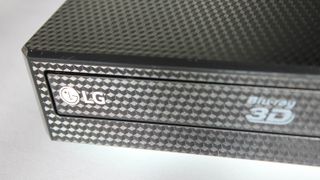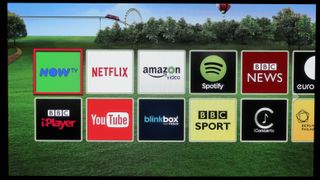TechRadar Verdict
This compact and affordable Blu-ray player not only spins discs, it also supports multiroom audio and has OTT streaming on tap.
Pros
- +
Great Blu-ray disc performance
- +
Netflix and Amazon onboard
- +
Connects to MusicFlow speakers
Cons
- -
Built to a (low) price
- -
Needs tinkering for optimum performance
- -
Rubbish video file playback
Why you can trust TechRadar
There’s been a good deal of fuss made about 4K UHD Blu-ray of late, but in the real world there’s still plenty of demand for regular 1080p HD Blu-ray players.
The format may be a decade old (how time flies), but for DVD replacers and first-gen BD upgraders, the sight of a relatively affordable Blu-ray deck can still make the AV pulse quicken.
The new LG BP556 doesn’t just spin discs for a living, it’s also a well-specified media hub, and can function as part of the brand’s MusicFlow wireless audio system. Want to stream CDs around the house? This is the deck that’ll do it.
Design
The BP556 is unashamedly unspectacular. But at just 270mm wide and 43mm tall, it’s easy enough to accommodate.
The thin fascia is plain. There's no display, just a front-facing USB port offset from the disc tray. The chassis might be lightweight, but it’s finished in a faux carbon fibre pattern which adds a level of visual interest.
Rear-side connections include a single HDMI plus coaxial digital audio output and Ethernet. 802.11 a/b/g/n Wi-Fi is integrated.

The deck comes with a stumpy IR remote, but it can also be controlled with LG's AV Remote app (available for iOS and Android). Opting for app control brings extra functionality. Private Listening allows you enjoy audio from the player on headphones via your mobile device, for example. You can also cast from content on your phone to the deck.
The player has a neat, graphical user interface. The main menu offers Movie, Photo, Music, Settings and Premium buttons. The latter groups various streaming content providers together, including Netflix, Amazon Video, Spotify, YouTube and Dailymotion, as well as Now TV, BBC iPlayer and Blinkbox in the UK in what is now known as the Talk Talk TV store.
The player is also DLNA savvy, through LG SmartShare. It picked up my Twonky and Plex servers, but usability is hampered by poor video playback. The player will unwrap MP3, WMA, AAC and FLAC music files (but not DSD), but I struggled to find video that it liked. MKV isn’t supported, and some MPEG clips are played without audio.

On the plus side, I was surprised at just how quickly the deck loaded Blu-rays. The mechanism may not be as quiet or slick as top-end machinery from Oppo, Sony et al, but it managed to take a java-heavy movie from tray to menu in just 44 seconds. A simple concert Blu-ray offered up its menu in only 29 seconds. In the world of Blu-ray, that’s rather rapid.
Performance
Picture quality is great. It's all too easy to forget just how fine a content source regular Blu-ray is, even from a modest box.
HD detail is high and artefact free (not something you can say about HD streaming sources), and of course multichannel audio is superb. I plumbed this cheapo deck into a reasonably well-specified home theatre system, and it delivered the goods. The picture quality from Star Wars: The Force Awakens was thrilling, while the Dolby Atmos soundtrack from John Wick was totally immersive.

You’ll need to rummage around the menus though if you want to make the most of this deck’s potential. If you’re using it with an AV receiver or high-end soundbar, bump the audio sampling frequency up from a default 48Hz to 96kHz or 192KHz. If you don’t, it’ll downscale any High-Res Audio tracks.
The digital output of the deck should also be left in Auto mode, to allow bitstreaming to a waiting AV receiver. If you select PCM, the player will encode soundtracks to stereo. Look out also for DRC (Dynamic Range Compression). This limits any dramatic increase in volume and it’s active out of the box, I would advise you to switch it off.
There's also an option for Quick Star in the menu, which helpfully shortens the start-up time.

Getting into the Flow
So far so … predictable. But things get interesting when you connect the player to LG MusicFlow speakers.
The LG AV app identifies any MusicFlow enabled speakers on your home network network, and then lets you stream to them. Pop a CD in, or stream a playlist from Spotify, and audio can be directed simultaneously to any connected speaker around the home.

What’s more, you can also distribute audio from any Blu-ray or DVD – great fun if you want to have your movie playing along in a kitchen or den. There is a catch though: If the player is in bitstream mode, because it’s delivering a Dolby or DTS soundtrack into a home theatre system, there’s an obvious delay between the main system and any connected speakers.
The solution is to switch the deck to stereo PCM, at which point all the connected MusicFlow speakers sync up.
Home entertainment AV specialist
Steve has been writing about AV and home cinema since the dawn of time, or more accurately, since the glory days of VHS and Betamax. He has strong opinions on the latest TV technology, Hi-Fi and Blu-ray/media players, and likes nothing better than to crank up his ludicrously powerful home theatre system to binge-watch TV shows.


